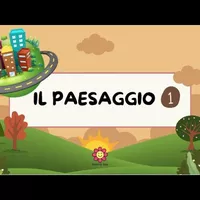IL PAESAGGIO - CHE COS'È - Geografia per i bambini
DIE LANDSCHAFT - WAS SIE IST - Geografie für Kinder
THE LANDSCAPE - WHAT IT IS - Geography for Children
EL PAISAJE - QUÉ ES - Geografía para niños
LE PAYSAGE - QU'EST-CE QUE C'EST - Géographie pour enfants
A PAISAGEM - O QUE É - Geografia para crianças
PEYZAJ - NEDİR - Çocuklar için Coğrafya
Ciao bambini! Oggi conosceremo i paesaggi.
Hello children! Today we are going to learn about landscapes.
Merhaba çocuklar! Bugün manzaralar hakkında bilgi edineceğiz.
Tu sai cos'è il paesaggio?
Do you know what landscape is?
Manzaranın ne olduğunu biliyor musun?
Il paesaggio è tutto ciò che vediamo intorno a noi.
Landscape is everything we see around us.
Manzara, etrafımızda gördüğümüz her şeydir.
Il paesaggio è l'aspetto, la forma di uno spazio.
Landscape is the appearance, the shape of a space.
Peyzaj, bir mekânın görünümü, şeklidir.
Uno spazio modellato dalla natura e dall'uomo.
A space shaped by nature and man.
Doğa ve insan tarafından şekillendirilmiş bir alan.
Avrai sicuramente notato che i paesaggi non sono tutti uguali.
You may have noticed that the landscapes are not all the same.
Manzaraların hepsinin aynı olmadığını fark etmiş olabilirsiniz.
Andiamo a conoscerli!
Let's get to know them!
Hadi onları tanıyalım!
La principale distinzione è quella dei paesaggi naturali e antropici.
The main distinction is that of natural and man-made landscapes.
Temel ayrım doğal ve insan yapımı manzaralar arasındadır.
I paesaggi naturali sono quelli dove l'uomo non ha mai costruito.
Natural landscapes are those where man has never built.
Doğal manzaralar, insanoğlunun hiç inşaat yapmadığı yerlerdir.
I paesaggi antropici sono ambienti trasformati dall'uomo per adattarli alle proprie esigenze.
Man-made landscapes are environments transformed by humans to suit their needs.
İnsan yapımı peyzajlar, insanın kendi ihtiyaçlarına uyarlamak için dönüştürdüğü ortamlardır.
Ora soffermiamoci sui paesaggi naturali.
Şimdi de doğal manzaralar üzerinde duralım.
I paesaggi naturali vengono classificati in base al rilievo.
Natural landscapes are classified according to relief.
Doğal peyzajlar rölyefe göre sınıflandırılır.
La pianura.
The plain.
Sade.
La collina.
Tepe.
La montagna.
Mountain.
Dağ.
La pianura è piatta, pianeggiante.
Ova dümdüz, düz.
La collina è poco alta, tondeggiante.
Tepe çok yüksek değil, yuvarlak.
La montagna, che come sai, è molto alta.
The mountain, which as you know, is very high.
Bildiğiniz gibi dağ çok yüksektir.
Passiamo ora ai paesaggi antropici, detti anche umanizzati o artificiali.
Şimdi insan eliyle yapılmış ya da yapay peyzajlar olarak da bilinen insan yapımı peyzajlara dönelim.
Nel corso del tempo, l'uomo ha trasformato molti spazi naturali.
Zaman içinde insanoğlu birçok doğal alanı dönüştürmüştür.
Ha costruito case, strade, fabbriche, scuole, per ripararsi e svolgere diverse attività.
Barınma ve çeşitli faaliyetler için evler, yollar, fabrikalar, okullar inşa etti.
Ha tagliato gli alberi per avere la terra da coltivare.
İşleyecek araziye sahip olmak için ağaçları kesti.
Ha costruito porti, strade, ferrovie per potersi muovere da un posto all'altro.
Bir yerden başka bir yere gidebilmek için limanlar, yollar, demiryolları inşa etti.
Nei paesi e nelle città è quasi tutta opera dell'uomo.
Kasaba ve şehirlerde neredeyse tamamı insan yapımıdır.
Il paesaggio di paesi e città si chiama paesaggio urbano.
Kasaba ve şehirlerin peyzajına kentsel peyzaj denir.
Abbiamo terminato!
İşimiz bitti!
Oggi hai imparato che esistono i paesaggi naturali e i paesaggi antropici, detti anche umanizzati e artificiali.
Bugün doğal peyzajlar ve insan yapımı peyzajlar olduğunu öğrendiniz, bunlara insan yapımı ve yapay peyzajlar da deniyor.

